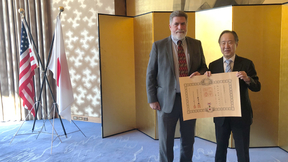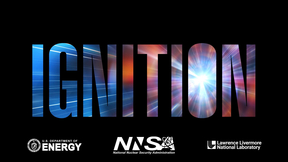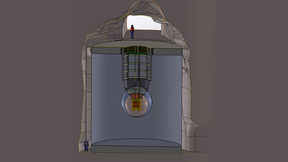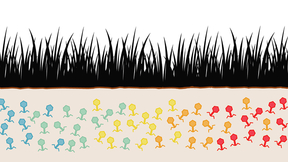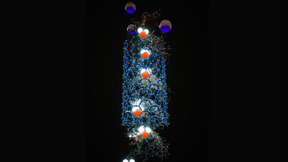Back
The Oppenheimer Science and Energy Leadership Program (OSELP) has selected four Lawrence Livermore National Laboratory (LLNL) scientists as 2023 fellows. Computational physicist Teresa Bailey, physicist Brent Blue, nuclear and mechanical engineer Lance Kim and chemical engineer Elizabeth Wheeler were inducted into the fellowship program. OSELP brings together exceptional…
Brad Roberts has received one of the highest honors bestowed by the Government of Japan. The director of the Center for Global Security Research (CGSR) at Lawrence Livermore National Laboratory (LLNL), Roberts has been given the Order of the Rising Sun, an honor awarded by the prime minister of Japan to people who have rendered distinguished service to the nation. The…
Watch the DOE press conference on NIF, which took place on Tuesday, Dec. 13.
Watch: LLNL Panel Q&A on NIF, which took place Tuesday, Dec. 13.
The U.S. Department of Energy (DOE) and DOE’s National Nuclear Security Administration (NNSA) today (Dec. 13) announced the achievement of fusion ignition at Lawrence Livermore National Laboratory (LLNL) — a major scientific breakthrough decades in the making that will pave the way for advancements in national defense and the future of clean power. On Dec. 5, a team at…
Call it the shot heard ‘round the world. The monumental, first-ever demonstration of fusion ignition by Lawrence Livermore National Laboratory’s (LLNL) National Ignition Facility (NIF) marks a potentially world-changing breakthrough for fusion energy and a key initial step in a decades-long quest for limitless clean energy, U.S. government officials and LLNL scientists…
X-ray diffraction measurements under laser-driven dynamic compression allow researchers to investigate the atomic structure of matter at hundreds of thousands of atmospheres of pressure and temperatures of thousands of degrees, with broad implications for condensed matter physics, planetary science and astronomy. Pressure determination in these experiments often relies on…
The San Joaquin Expanding Your Horizons (SJEYH) conference celebrated its 30th anniversary with the theme "STEM: It's Like Magic, but Real," on Saturday, Nov. 5, bringing more than 250 girls (and some boys) to the University of the Pacific (UOP) campus in Stockton to learn more about science, technology, engineering and mathematics (STEM). Co-sponsored by Lawrence…
"Dwell fatigue" is a phenomenon that can occur in titanium alloys when held under stress, such as a jet engine's fan disc during takeoff. This peculiar failure mode can initiate microscopic cracks that drastically reduce a component's lifetime. The most widely used titanium alloy, Ti-6Al-4V, was not believed to exhibit dwell fatigue before the 2017 Air France Flight 066…
Immune responses could be supported by drugs to help people recover from brain infections caused by Rift Valley fever virus Research by Lawrence Livermore National Laboratory (LLNL) scientists suggests that immune responses could be bolstered by drugs to help people recover from brain infections caused by an emerging pathogen. The emerging pathogen studied by the team,…
Lawrence Livermore National Laboratory (LLNL) scientists Félicie Albert and Craig Siders have been selected as fellows of Optica (formerly OSA). Fellows are selected based on several factors, including distinguished contributions to education, research, engineering, business and serving the optics and photonics community. Click here to see the entire Optica 2023 class…
As Lawrence Livermore National Laboratory (LLNL) recruits top talent for more than 500 open positions across all directorates and disciplines, hundreds of LLNL hopefuls lined up around the outside of the building and down the sidewalk on Wednesday to enter the Lab’s first-ever onsite career fair. Interest in joining the Lab is high, especially with layoffs affecting many…
The Society for Industrial and Applied Mathematics (SIAM) and Association for Computing Machinery (ACM) announced that they have awarded the 2023 SIAM/ACM Prize in Computational Science and Engineering to the team behind the Lawrence Livermore National Laboratory (LLNL)-developed SUNDIALS software suite. The prestigious award is handed out every two years and recognizes…
The High-Performance Computing for Energy Innovation (HPC4EI) initiative has opened its fall 2022 solicitation cycle to industry partners interested in collaborating with the Department of Energy (DOE) to address key energy and decarbonization-related challenges. The sponsors of this solicitation are the HPC4Manufacturing (HPC4Mfg) and HPC4Materials (HPC4Mtls) programs,…
Lawrence Livermore National Laboratory (LLNL) has received $2.35 million from the Inflation Reduction Act, which aims to support domestic energy production and promote clean energy and to provide the Department of Energy (DOE) national laboratories with resources to keep the U.S. at the forefront of scientific discovery. The funding has been allocated for the Lab-led nEXO…
Soils contain diverse communities of microorganisms, including bacteria, fungi, protists and viruses. Interactions between these tiny organisms shape the ability of soils to store carbon underground. However, not much is known about the spatial patterns and dynamics of viral communities in soil. New research by Lawrence Livermore National Laboratory (LLNL) scientists and…
Lawrence Livermore National Laboratory researchers are starting work on a three-year project aimed at improving methods for visual analysis of large heterogeneous data sets as part of a recent Department of Energy funding opportunity. The joint project, titled “Neural Field Processing for Visual Analysis,” will be led at LLNL by co-principal investigator (PI) Andrew…
Transforming the way energy is collected, stored and used has become a defining challenge of the 21st century. To address this task, the Department of Energy’s (DOE) Office of Basic Energy Sciences (BES) established the Energy Frontier Research Center (EFRC) program. This year, Lawrence Livermore National Laboratory and collaborators were awarded three projects. The first…
A five-year microbial study of the International Space Station (ISS) and its astronauts by Lawrence Livermore National Laboratory (LLNL) and NASA researchers has found that the ISS habitat is safe for its residents. The research effort represents the first comprehensive characterization of the space station’s environmental profile (or microbiome) and is the first to…
Lawrence Livermore National Laboratory (LLNL) scientists are scaling up the production of vertically aligned single-walled carbon nanotubes (SWCNT) that could revolutionize diverse commercial products ranging from rechargeable batteries, automotive parts and sporting goods to boat hulls and water filters. The research appears in the journal Carbon. Most CNT production…


